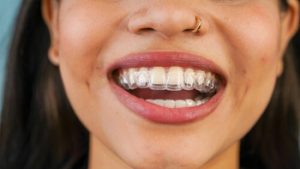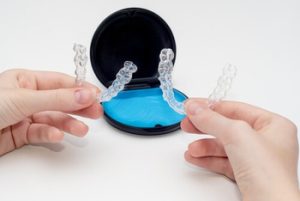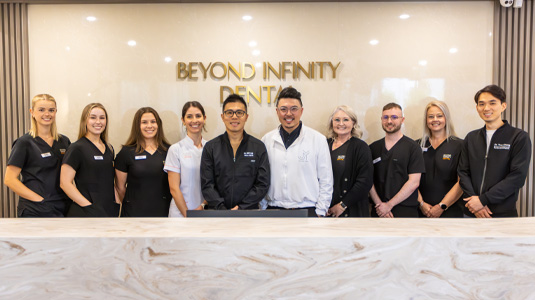If you’ve ever felt self-conscious about your teeth or hesitated to smile in photos, you’re not alone. From crowded teeth and bite issues to aesthetic concerns, many Australians seek a discreet and effective way to straighten their smiles. That’s where Invisalign comes in. But one big question remains: Is Invisalign worth it?
This blog will take you through the benefits, costs, treatment expectations, and how Invisalign stacks up against traditional braces. No matter if you’re starting to explore Invisalign or weighing up your options, this guide is here to help you make a confident, informed choice.
What Is Invisalign?
Invisalign is an innovative orthodontic treatment that uses clear aligners made of smooth plastic to gradually shift teeth into a more ideal position. These nearly invisible aligners are customised for your mouth, allowing for a personalised treatment plan tailored to your specific needs.
Unlike traditional metal braces, Invisalign aligner trays are removable, comfortable, and carefully designed to fit seamlessly into your lifestyle.
Why Do People Choose Invisalign?
 People turn to Invisalign for many reasons, ranging from cosmetic improvements to addressing more complex orthodontic issues. Here are some of the most common motivations:
People turn to Invisalign for many reasons, ranging from cosmetic improvements to addressing more complex orthodontic issues. Here are some of the most common motivations:
- Discreet appearance: Invisalign trays are nearly invisible
- Comfort: Made from smooth plastic, they don’t irritate your cheeks or gums like metal braces
- Convenience: You can easily take the aligners off to eat, brush, and floss
- Flexibility: Fewer clinic visits compared to conventional braces
Invisalign represents a more modern, lifestyle-friendly treatment option for many orthodontic patients, especially adults and teens.
Understanding the Invisalign Treatment Process
Before you commit to Invisalign, it’s helpful to understand what the journey looks like. From your first consultation to wearing your final set of aligners, the process is carefully planned to give you a straighter, healthier smile with minimal disruption to your daily life. Let’s walk through the key steps so you know exactly what to expect.
Step 1: Initial Consultation
Your Invisalign journey starts with a consultation. During this visit, your dentist will examine your teeth, gums, and jaw alignment using digital scans or impressions to see if you’re a good candidate, particularly if you have mild to moderate orthodontic concerns.
Step 2: Personalised Treatment Plan
Using advanced software, your provider creates a personalised treatment plan that maps out each movement your teeth will make. This step also estimates the treatment duration, which typically ranges from 6 to 24 months, according to the complexity of the case.
Step 3: Wearing Your Aligners
You’ll receive a series of Invisalign aligner trays, which you’ll wear for about 22 hours a day. The trays are changed every 1–2 weeks, gradually shifting your teeth into a straighter position. You must wear your aligners consistently for effective results.
Thinking About Invisalign? These Benefits Might Convince You
Let’s take a closer look at the key benefits that make many say Invisalign is worth the investment.
1. Nearly Invisible and Aesthetically Pleasing
The clear design of Invisalign aligners means you can straighten your teeth without the annoyance of drawing attention to your dental treatment. This is ideal for professionals, teens, or anyone concerned with how braces might impact their appearance.
2. Comfortable to Wear
Made from medical-grade smooth plastic, these aligners avoid the mouth abrasions often caused by metal braces or ceramic braces.
3. Removable and Easy to Clean
Because they’re removable aligners, you can take them out when eating or brushing, letting you maintain good oral hygiene. There’s no need to navigate around brackets and wires.
4. Fewer Emergencies
Unlike traditional braces, there’s no risk of wires snapping or brackets loosening, which means fewer unplanned visits to the clinic.
5. Custom-Fit and Smart Technology
Invisalign relies on 3D imaging to tailor your treatment plan, making it an efficient solution even for some complex cases.
Is Invisalign Effective for All Cases?
 Invisalign has come a long way since it first entered the dental space. It’s now suitable for:
Invisalign has come a long way since it first entered the dental space. It’s now suitable for:
- Crooked teeth
- Crowded teeth
- Bite issues, such as overbite or underbite
- Mild to moderate orthodontic issues
However, for severe orthodontic issues, such as significant jaw misalignment or extreme rotation of teeth, traditional metal braces or conventional braces may still be the recommended approach.
How Much Does Invisalign Cost in Australia?
One of the biggest factors in the “is Invisalign worth it?” debate is cost. So, how much does Invisalign cost?
The cost of Invisalign in Australia typically starts at 6,000 AUD and can go up. Some insurance coverage may include orthodontic treatment, so check with your provider to understand your benefits.
What Factors Influence Invisalign Cost?
Let’s break down the several factors that affect the overall cost of Invisalign:
- The severity of misalignment: More complex orthodontic issues usually mean you’ll need additional aligner trays and a longer treatment timeline.
- Provider experience: Highly experienced professionals may charge more for their expertise
- Number of aligners: The more aligners you need, the higher the cost
- Extra features: Such as teeth whitening, attachments, or retainers
- Follow-up visits: More complex cases may need closer monitoring
Are There Cheaper Alternatives?
Yes, alternatives like traditional braces, ceramic braces, or newer mail-order plastic aligners exist. However, these alternatives may not offer the same level of personalised dental care, precision, or long-term reliability as Invisalign clear aligners.
If your primary concern is aesthetics and mild correction, you might still consider Invisalign as an alternative to traditional braces.
What Are the Challenges of Invisalign?
While the benefits are impressive, no treatment is perfect. Here are some common concerns:
Discipline Required
You must wear aligners regularly, about 22 hours a day. Skipping days can set back your treatment.
Attachments and Refinements
In some cases, your Invisalign treatment may include attachments (small tooth-coloured bumps) or refinements (extra trays) that can extend the treatment duration.
Soreness and Speech Changes
Some patients initially experience mild discomfort or a slight lisp. However, these issues are usually resolved within a few days.
Invisalign vs Traditional Braces: What Sets Them Apart?
When deciding between Invisalign and traditional braces, it’s helpful to understand how they differ. Here are the key differences to consider:
Appearance
Invisalign aligners are transparent and nearly invisible, making them a discreet option. Traditional braces, on the other hand, include wires and metal or ceramic brackets that are more noticeable.
Comfort
Invisalign is made from smooth plastic, which is less likely to lead to irritation to the cheeks and gums. Traditional braces may cause discomfort due to brackets and wires.
Removability
Invisalign aligners are removable, so you can remove them to eat, brush, and floss. Traditional braces are fixed in place and stay on until your treatment ends.
Oral Hygiene
It’s easier to keep up with a proper oral hygiene with Invisalign because you can remove the trays and clean your teeth normally. Traditional braces can make brushing and flossing more difficult.
Food Restrictions
With Invisalign, you can enjoy all your favourite foods because you simply remove the aligners before eating. Braces, however, come with dietary restrictions: sticky, hard, or chewy foods are typically off-limits to avoid damaging the brackets or wires.
Suitability
Invisalign is most effective for mild to moderate orthodontic concerns. Traditional braces, on the other hand, are often better suited for more complex cases and a broader range of alignment issues.
Clinic Visits
Invisalign usually requires fewer and shorter appointments. Braces may require more repeated visits for adjustments.
Cost
Invisalign tends to be slightly more expensive, depending on the complexity of the case. Braces are generally more affordable but may come with extra maintenance or repair costs.
Maintaining Oral Hygiene During Treatment
A big plus of using Invisalign aligners is that they allow you to maintain good oral hygiene. But that doesn’t mean you can skip your routine.
Here’s what you should do:
- Brush with a soft toothbrush after every meal.
- Floss daily.
- Rinse aligner trays before putting them back in.
- Soak aligners as instructed by your dentist in a cleaning solution.
Remember, good oral hygiene during treatment leads to improved oral health and a healthier smile at the end of your Invisalign journey.
Who Is the Ideal Candidate for Invisalign?
 You’re likely a good fit if:
You’re likely a good fit if:
- You have mild to moderate misaligned teeth
- You’re committed to wearing the aligners
- You value aesthetics and comfort
- You have realistic expectations about the treatment duration
If you’re unsure, an initial consultation with a qualified dentist can clarify whether Invisalign is right for you, depending on your individual case.
So, Is Invisalign Worth It?
If you’re looking for a straighter smile, value flexibility, and are ready to commit, then yes, Invisalign is worth considering. It’s especially suited to people who:
- Prefer a discreet treatment
- Want to maintain oral hygiene with ease
- Have mild to moderate orthodontic issues
- Are committed and disciplined when it comes to wearing their aligners as directed each day
However, for those with complex orthodontic issues, conventional braces may be the better choice.
Final Thoughts: It’s Your Smile, Make It Count
Deciding on an orthodontic treatment is a personal journey. Invisalign treatment largely depends on your goals, commitment, and budget. While the cost of Invisalign may be higher than traditional braces, the comfort, flexibility, and discretion it offers can make it a valuable investment.
Ready to explore your options? Book an Invisalign consultation with Beyond Infinity Dental at (02) 8806 3799 to find out if it’s the right fit for your smile and lifestyle.
References
- Healthline. Does Invisalign work? Retrieved from https://www.healthline.com/health/does-invisalign-work
- Medical News Today. Metal braces: Uses, costs, benefits, and more. Retrieved from https://www.medicalnewstoday.com/articles/metal-braces-uses-costs-benefits-and-more-2
- Cleveland Clinic. Oral hygiene. Retrieved from https://my.clevelandclinic.org/health/treatments/16914-oral-hygiene
- American Association of Orthodontists. Common orthodontic problems. Retrieved from https://aaoinfo.org/resources/common-orthodontic-problems/









